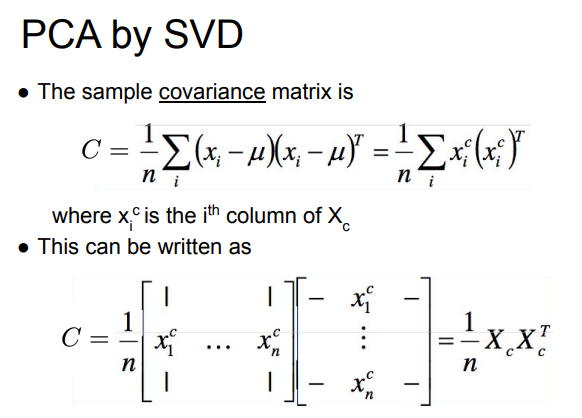- The main goal of a PCA analysis is to identify patterns in data
- PCA aims to detect the correlation between variables.
- If a strong correlation between variables exists, attempt to reduce the dimensionality
- Finding the directions of maximum variance in high-dimensional data and project it onto a smaller dimensional subspace while retaining most of the information. (see covariance)
- geometric interpretation:
- find projection that maximizes variance
intuition:
- high dim data lives in some lower dim space?
- covariance between two dims of fts is high - can we reduce to 1?
overview
-
Standardize the data.
- center the data by subtracting the mean to each col of X
-
Get covariance matrix

-
Obtain the eigenvectors and eigenvalues from the covariance matrix or correlation matrix, or perform singular value decomposition (SVD)


- U is orthonormal, sigma^2 is diagonal → this is the eigenvalue decomp of C → we can calc eigenvectors of C using eigenvectors of X_c
- eigenvecs of C are columns of U
- eigenvals of C are diagonal entries of sigma
- Sort eigenvalues in descending order and choose the k eigenvectors that correspond to the k largest eigenvalues where k is the number of dimensions of the new feature subspace (k≤d).
- Construct the projection matrix W from the selected k eigenvectors.
- Transform the original dataset X via W to obtain a k-dimensional feature subspace Y.
summary of pca by svd
- center data matrix
- compute its SVD
- PCs of covariance matrix C are columns of U
pca during training
- an image is a point in high-dim space
- if A is symmetric, it can be decomposed
limitations
- PCA works by projecting data onto the direction of maximum variance, preserving as much information as possible when compressing high-dimensional data.
- maximizes ability to reconstruct each image, but not optimized for classification
- but if we want to keep diff classes separable…
- PCA may project two diff classes onto an axis where their variances overlap, making them indistinguishable
- fix: Linear Discriminant Analysis (LDA)
